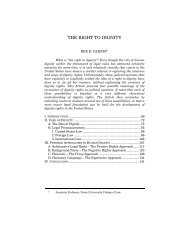A Right to Media? Lorie M. Graham - Columbia Law School
A Right to Media? Lorie M. Graham - Columbia Law School
A Right to Media? Lorie M. Graham - Columbia Law School
Create successful ePaper yourself
Turn your PDF publications into a flip-book with our unique Google optimized e-Paper software.
498 COLUMBIA HUMAN RIGHTS LAW REVIEW [41:429<br />
demonstrated through recent constitutional reform. In Norway, the<br />
constitution states that “[i]t is the responsibility of the authorities of<br />
the State <strong>to</strong> create conditions enabling the Sami people <strong>to</strong> preserve<br />
and develop its language, culture and way of life.” 283 This can provide<br />
legal and political protection for Sami language and culture, which in<br />
turn can support governmental involvement in the development of<br />
Sami media as a means of preserving language and culture. 284<br />
Similar protection can be found in the Finnish constitution, which<br />
speaks <strong>to</strong> the question of cultural and linguistic au<strong>to</strong>nomy. 285<br />
Moreover, Finland, Sweden, and Norway have all adopted Sami<br />
language acts. 286 These acts recognize, <strong>to</strong> varying degrees, Sami<br />
languages as official languages throughout the region. 287<br />
These legislative and constitutional initiatives are important<br />
steps <strong>to</strong> promoting substantive cultural and linguistic rights for the<br />
Sami. However, constitutional and legislative acknowledgment does<br />
not by itself guarantee that meaningful change will necessarily<br />
follow. In fact, the Sami have faced considerable obstacles <strong>to</strong> the<br />
creation of their own media.<br />
Sami media receives government funding in all three<br />
Scandinavian countries and there are efforts underway in countries<br />
such as Norway <strong>to</strong> increase funding for Sami newspapers and<br />
television programs. 288 However, inconsistencies in funding regimes<br />
create challenges <strong>to</strong> the viability of Sami newspapers and other forms<br />
of media throughout the region. Similarly, there is a lack of funding<br />
and technical assistance for Sami media professionals. For instance,<br />
while the Norwegian Broadcasting Corporation has financed Sami<br />
283. Constitution art. 110(a) (Nor.).<br />
284. Id.<br />
285. Constitution of Finland § 17 (“The Sami, as an indigenous people, as<br />
well as the Roma and other groups, have the right <strong>to</strong> maintain and develop their<br />
own language and culture.”). See also Act on the Sami Parliament, No. 974 § 9<br />
(1995) (Fin.) (providing that the national authorities have an obligation <strong>to</strong><br />
negotiate “with the Sami Parliament on all extensive and important questions<br />
that can directly or distinctly influence the Samis’ position as an indigenous<br />
people.”).<br />
286. Act on the Sami Parliament, No. 974 § 3 (1995) (Fin.); The Sami Act,<br />
No.56 § 2-6 (1987) (Nor.); Sami Parliament Act (SFS 1992:1433) (Swed.). See<br />
Regional Characteristics Of Sápmi And The Sami People, supra note 280.<br />
287. Act on the Sami Parliament, No. 974 § 3 (1995) (Fin.); The Sami Act,<br />
No.56 § 2-6 (1987) (Nor.); Sami Parliament Act (SFS 1992:1433) (Swed.). See<br />
Regional Characteristics Of Sápmi And The Sami People, supra note 278.<br />
288. Regional Characteristics Of Sápmi And The Sami People, supra<br />
note 280.















